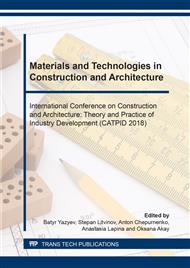p.3
p.9
p.14
p.19
p.24
p.30
p.36
p.42
p.47
The Influence of Cross Section Shape on Strengthening of Hollow Core Slabs
Abstract:
Increasing pressure in separate areas when reconstructing and improving industrial buildings, may necessarily mean strengthening structural surfaces of buildings. In experimental and analytical assessment hollow cores slabs are represented as T-beams and I-beams. The width of the beam edge decreases according to the dimensions of the voids inside the slab. In this paper the authors test bearing strength and deformability of hollow core slabs in different conditions of strengthening. Furthermore, the scholars perform their calculations in a non-linear system, with a progressive loading, until the samples are destroyed, with a plastic hinge formed in the area extended in a slab cross section. Simulation and figure analyses were designed in ANSYS program. The researchers’ resulting of the stress-strain state of hollow core slabs is observed experimentally at various stages of loading. The researchers compared calculations of slabs with the full-scale cross section shape and calculations of the same I-beam slabs. Though, the investigators dwell on the impact of the cross-section on the results of the maximum slab deflections. The paper is also dedicated to a variety of strengthening modes and it explains that the cracking point for full-scale slabs comes after.
Info:
Periodical:
Pages:
24-29
Citation:
Online since:
September 2018
Authors:
Price:
Сopyright:
© 2018 Trans Tech Publications Ltd. All Rights Reserved
Share:
Citation:


